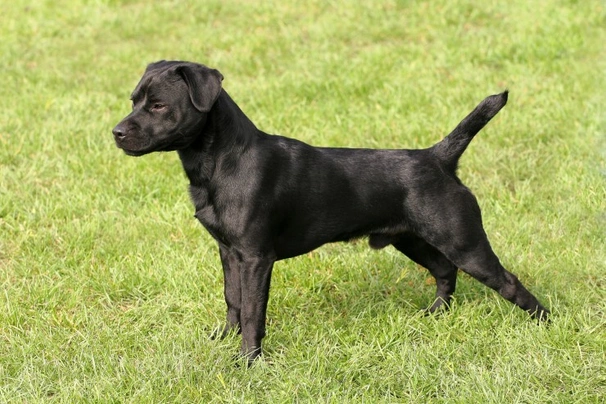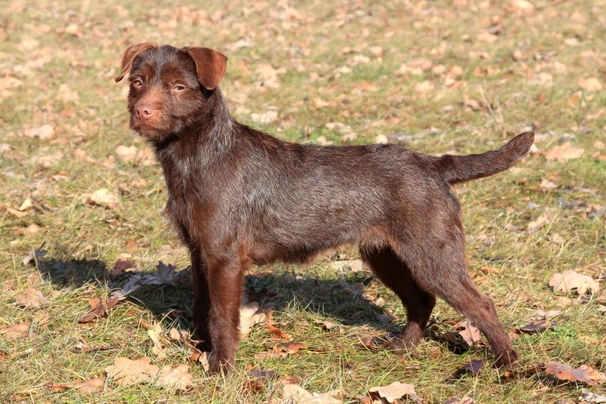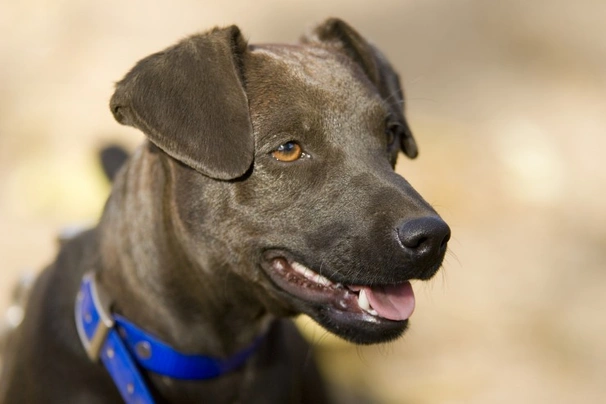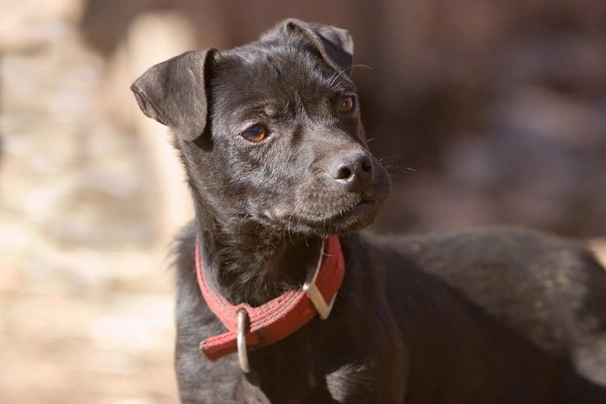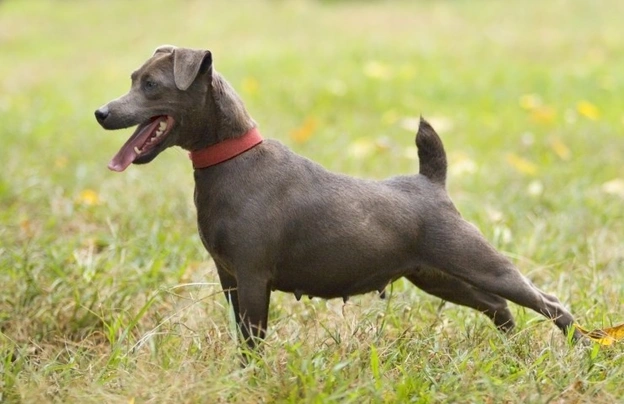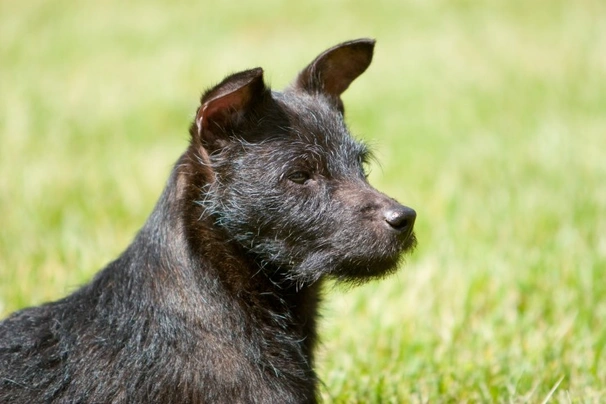Patterdale Terrier
Pros
Cons
Introduction of the Patterdale Terrier
Patterdale Terriers were first bred in the Lake District where they were prized for their hunting abilities thanks to their small size and keen senses. Over time these little terriers became a popular choice both as companion dogs and family pets with many people here in the UK and in other areas of the world and for good reason because these little terriers boast having loyal and friendly natures.
The Patterdale is not recognised as a breed by The Kennel Club although they have been recognised by the UKC and the American Rare Breed Association although it is worth noting that the Patterdale is not a vulnerable breed having found a fan base in a home environment as well as in the field. As such there is not set breed standard for Patterdales although responsible breeders are working hard to establish one.
History of the Patterdale Terrier
Patterdale Terriers are a relatively new dog to appear on the scene having been bred in the sixties by Brian Nuttall from dogs he had been given by his grandfather. He used Buck and Breay bloodlines to produce his own namely the Nuttall bloodline which even today is regarded as one of the best in the country and as such puppies command a high price for the good breeding.
As previously mentioned these little terriers were developed in the Lake District where the climate and environment is harsh and hilly. It's where flocks of sheep graze and where foxes were and are a problem. It was for this reason that farmers needed a robust hardy dog capable of working and protecting flocks in harsher environments against predators.
Unlike other terriers that were trained to go to ground after their prey without killing it the Patterdale was trained to dispatch their prey if prey stood their ground and fought back a Patterdale knew how to deal with things rapidly and efficiently. Often referred to as Black Fell Terriers the Patterdale was first bred over a 100 years ago and they were given their name after a village in the Lake District called Patterdale.
Patterdales have a quite unique ability which is to compress their chests and this enables them to get down small burrows and holes. They are also capable of lying completely flat on their bellies with their back legs outstretched and their front ones stretched forwards which helps them reach prey that’s gone to ground. Patterdales were bred to be as "hard as nails" which paired to their courage makes them formidable hunting dogs.
Today Patterdale Terriers are kept more as companion dogs and family pets thanks to their charming looks and kind albeit very alert natures. As previously mentioned they are recognised in the UK by The Kennel Club but Patterdales are a recognised breed by the United Kennel Club.
Interesting facts about the breed
- Is the Patterdale a vulnerable breed? No they are one of the most popular new hybrid dogs to have been developed over recent times
- Patterdales were given their name after a village in the Lake District
- Patterdales can squeeze down the smallest of holes thanks to the fact they can compress their chests
- Patterdales may be small but they have a tremendous amount of stamina which means they can easily keep up with a horse
- The first Patterdale to be bred was a dog called Bingo whose coat was a red colour
Appearance of the Patterdale Terrier
Height at the withers: Males 25 - 38 cm Females 25 - 38 cm
Average weight: Males 4.5 - 11 kg Females 4.5 - 11 kg
Patterdales are bred as working dogs and they are not often seen in the showring because reputable breeders focus more on a dog's ability to work rather than how they look.
Patterdales are attractive little terriers that boast having all the usual "terrier" traits which includes a lively alert eye. They are nicely proportioned compact dogs that present a well-balanced appearance. As previously mentioned they can compress their chests which allows them to squeeze down the smallest of holes to reach any quarry they have tracked down.
They have strong powerful looking heads which are well proportioned in relation to the rest of their body. Heads are trapezoidal or wedge shaped when seen from the front. Muzzles are strong and quite broad for such small dogs. They boast having a perfect scissor bite where their upper teeth neatly overlap their lower ones although a level bite is also allowed under the UKC breed standard rules.
Their eyes are set squarely and nicely apart on their heads and should match a dog's coat colour. Ears are triangular shaped and can either be small or moderate in size folding neatly just above a dog's head with the tips pointing to the outside corner of a dog's eye. Their noses are black except when the coat is liver/chocolate in which case a dog's nose can be brown.
Their necks are well-muscled and moderately long widening from the nape down to a dog's shoulders so they blend in nicely. Shoulders are sloping well laid back and long with dogs have strong straight front legs that show lots of bone. Patterdales boast having compact nicely squared bodies with strong well-muscled backs and slightly arched loins. Bellies are moderately tucked up which adds to the Patterdale's athletic appearance. Chest are firm and deep yet moderately wide and oval shaped.
Their hindquarters are well muscled and strong with dogs having muscular back legs that show they can achieve a quick turn of speed when needed. Feet are compact with firm pads and tails are set high which these terriers always carry gaily.
When it comes to their coat the Patterdale Terrier can have either a smooth rough or broken coat with a dense undercoat. When their coat is smooth the hair is dense stiff and coarse to the touch. Dogs with broken coats have longer guard hairs and these are that much coarser to the touch. A rough coat can be slightly wavy with terriers often having eyebrows a beard and moustache with dogs having coarse and longer hair all over their bodies which includes on their face and their ears. The accepted UKC breed colours include the following although it would be fair to say that a very high percentage (95%) of Patterdales have black coats with a tinge of bronze shining through:
Grizzle
Chocolate
Red/tan
Liver - dogs have a red nose
Black and tan
Patterdales have white paws and some white on their chests no matter what colour they are.
Gait/movement
When a Patterdale moves they do so with determination covering a lot of ground when they do. They show a lot of power in their hindquarters and are light on their feet.
Faults
Reputable breeders concentrate on producing Patterdales with good conformation which enhances their ability to work and would frown on any exaggerations that are deliberately breed into the breed that would negatively affect their overall health and wellbeing as well as a dog’s ability to work.
Temperament of the Patterdale Terrier
True to their terrier traits the Patterdale is an energetic confident and quite independent little dog by nature while at the same time being affectionate and loyal when they are around people other dogs and even livestock. They have an extremely strong prey drive and for such a small dog they boast having a surprisingly loud bark. They have perfected the art of crawling on their bellies which is extremely useful when they need to get to any prey that goes to ground. They are also capable of compressing their lungs so they can get down the smallest of holes to reach their quarry which is something that should be accounted for when a Patterdale is allowed to run free in a garden.
With this said the Patterdale cannot resist digging and will happily dig their way out of a garden if the mood takes them. If left at home on their own for long periods of time they are likely to dig their way through furniture and carpets too. They also like the sound of their own voices and if barking issues are not nipped in the bud at an early age it can turn into a real problem. With this said if a Patterdale is given the right amount of daily exercise and mental stimulation they are highly adaptable terriers and do just as well in an apartment as they do in a country environment.
They are extremely people-friendly and love nothing more than being in a family environment getting on well with children of all ages which is why they make such great family pets. However they are not the best choice for first time owners because these little terriers need to be trained and handled by someone who is familiar with the needs of the breed or similar type of terrier and who therefore understands how to train and handle them.
Are they a good choice for first time owners?
Patterdales are not the best choice for first time dog owners because they are incredibly smart and if not well socialised trained and handled they can quickly get the better of people. They are better suited to people who lead active outdoor lives and who are familiar with the specific needs of this type of high energy and active terrier.
What about prey drive?
Being a terrier and one that was bred to track down prey and deal with it efficiently the Patterdale has a very high prey drive even when kept in a home environment because it is a trait that is deeply embedded in a dog's psyche. As such care should always be taken when walking a Patterdale off their leads anywhere near smaller animals.
What about playfulness?
Patterdales are playful dogs by nature and thoroughly enjoy playing interactive games. They are also known to be good at all sorts of canine sports which includes flyball and agility.
What about adaptability?
Although small in stature a Patterdale is a very high energy dog and therefore would not be happy living in an apartment. They are much better suited to people who lead active outdoor lives and who would like an energetic canine companion at their side. With this said Patterdales need to be able to express themselves as they should with as much "off the lead" time as possible but only in a safe environment or a secure back garden.
What about separation anxiety?
Patterdales form strong ties with their owners and as such they never really like being left on their own for any length of time. This could lead to a dog suffering from separation anxiety and their way of relieving stress is to be destructive and noisy around the home.
What about excessive barking?
Patterdales like the sound of their own voices and will happily bark at just about anything which can become a real problem if not gently nipped in the bud when a dog is still young and even then it can be challenging when it comes to stopping them from barking.
Do Patterdales like water?
Some Patterdales enjoy being in the water and will take a swim whenever they get the chance which is why care should always be taken when walking a dog off the lead anywhere near dangerous watercourses just in case a dog decides to leap in. With this said it would be a mistake to force a dog into the water if they don't like it because it would end up stressing them out unnecessarily.
Are Patterdales good watchdogs?
Although small Patterdales are good watchdogs because they are protective of their environment and will bark if strangers are about or if something they don't like is going on around them. However because they are known to be "barkers" false alarms can be a frequent occurrence which can be frustrating for owners.
Intelligence / Trainability of the Patterdale Terrier
Patterdale Terriers are very intelligent and this paired to the fact they love to please their owners makes them highly trainable. However their socialisation and training must start as early as possible and it has to be consistent for these terriers to understand their place in the pack and who is alpha dog in a household.
In the right hands and with the correct amount of training a Patterdale can be taught to do all sorts of things which includes taking part in many canine sports because they are so very tenacious by nature. Particular attention must be paid to the "recall" command when a Patterdale is still young because of their high prey drive which in short means that if they spot something in the distance without a strong recall they are more likely to take off after their prey turning a deaf ear to their owners. The good news is they will usually come back but only in their own time.
Puppies should be taught the ground rules as early as possible so they understand the limits and boundaries an owner sets for them bearing in mind that being terriers they will always test these whenever they can to see how much they can get away with. The first commands a puppy should be taught are as follows:
- Come
- Sit
- Stay
- Quiet
- Leave it
- Down
- Bed
Children and other
Patterdale Terriers do make great family pets and love nothing more than playing interactive games with the children which includes activities that involve balls and other objects providing they are given lots of attention mental stimulation and daily physical exercise. However any interaction between dogs and children should be supervised by an adult to make sure playtime does not get too boisterous which could end up with a child getting scared or hurt.
If a Patterdale has grown up with a family cat in a household they generally get on well together although a dog might decide to give chase when the mood takes them but this generally ends amicably or the result of a confrontation usually sees the cat winning and the dog backing down. However these little terriers would think nothing of chasing a neighbour's cat if and when they get the chance which can end in disaster.
Care should be taken when they are around smaller pets because of their high prey drive but again if a Patterdale has grown up with smaller furry pets in the home they generally tolerate having them around. If well socialised these little terriers generally get on well with other dogs although they can play a little too roughly even with other dogs which is something owners need to bear in mind when walking a dog off the lead in a public area although they are known to be good around farm animals and this includes poultry.
Health of the Patterdale Terrier
The average life expectancy of a Patterdale Terrier is between 12 and 15 years when properly cared for and fed an appropriate good quality diet to suit their ages.
The Patterdale is known to suffer from very few hereditary health issues being a robust and healthy litter dog. The condition that seems to affect the breed the most is as follows:
- Eye issues - mainly conjunctivitis
- Primary lens Luxation (PLL) - test available through the Animal Health Trust
More about conjunctivitis
One of the main health concerns seen in the Patterdale is conjunctivitis which is a common eye issue reported in the breed. If a dog shows any signs of irritation swelling around the eye and they are squinting and scratching at an affected eye it is time to get them to the vet sooner rather than later.
More about primary lens luxation (PLL)
Primary lens luxation is a painful disorder that can be genetically passed on to offspring of many types of terrier including the Patterdale. Studies have managed to determine the gene mutation responsible for PLL and as such a DNA test is available through The Animal Health Trust. Dogs tested clear can be used in breeding programmes although PLL can be caused for other reasons which includes trauma and other unidentified gene mutations.
An "Affected" Patterdale would have inherited two copies of the mutation from both parent dogs whereas a "Carrier" would only have been passed one copy of the mutation and one normal gene. Carriers would not normally develop the problem in their lives but they may well pass it on to their offspring if used in a breeding programme.
More about tail docking
Traditionally Patterdales always had their tails docked to prevent them injuring their tails when working and so that handlers could easily and quickly pick up a dog by the tail when necessary. However it is now illegal to dock a dog's tail unless it is for medical reasons or because a Patterdale is going to be used as a working dog. The procedure must be carried out by a qualified vet who would agree to tail docking but only if the correct paperwork has been provided.
What about vaccinations?
A Patterdale puppy would have been given their vaccination before being sold but it is up to the new owner to make sure they have their follow-up shot in a timely fashion. The vaccination schedule for puppies is as follows:
- 10 -12 weeks old bearing in mind that a puppy would not have full protection straight away but would be fully protected 2 weeks after they have had their second vaccination
There has been a lot of discussion about the need for dogs to have boosters. As such it's best to talk to a vet before making a final decision on whether a dog should continue to have annual vaccinations which are known as boosters.
What about spaying and neutering?
A lot of vets prefer to wait until a Patterdale is slightly older before spaying or neutering them because they think it's better to carry out the procedures when dogs a slightly more mature. As such they recommend spaying a female and neutering a male when they are anything between the ages of 6 months to 9 months old. Other vets recommend carrying out the procedures when dogs are 6 months old but never when they are any younger unless for medical reasons.
What about obesity problems?
Because Patterdales are such high-energy active little dogs they are not prone to putting on too much weight. With this said when a dog is spayed or neutered they can put on a little weight and the same can be said of older dogs which is when it's important to keep an eye on a pet's waistline and to adjust their calorie intake and the amount of physical daily exercise they are given. Obesity can seriously and negatively impact a dog's overall health and wellbeing shortening their lives by several years.
What about allergies?
Some Patterdales may develop a skin allergy which could be triggered by several things and often finding out why a dog has a flare up can prove challenging. The sooner a dog is seen by a vet the quicker they can be made to feel more comfortable although as previously mentioned finding out what's causing the problem takes time and a lot of effort. The most common triggers however are as follows:
- Environment
- A reaction to certain chemicals commonly found in household cleaning products
- Seasonal allergies which includes pollen and grasses
- Food which includes certain meats and cereals often used as ingredients in commercially produced dog food
- Tick and flea bites
- Dust mites
- Mould
Participating in health schemes
For the moment the Patterdale is not a recognised Kennel Club breed as such there are no BVA/KC tests available. With this said prospective owners should always discuss any health issues like conjunctivitis with breeders before buying a puppy from them. However there is a DNA test available for primary lens luxation which is provided by The Animal Health Trust which breeders should discuss with a vet so dogs can be referred to the AHT before being used for breeding purposes.
What about breed specific breeding restrictions?
Currently there are no breed specific breeding restrictions for the Patterdale because they are not a recognised Kennel Club breed. Prospective owners should however always contact reputable breeders when thinking about buying a Patterdale puppy.
What about Assured Breeder Requirements?
There are no Assured Breeder requirements for the Patterdale because as of September 2017 they are not a Kennel Club recognised breed.
Caring for the Patterdale Terrier
As with any other breed Patterdales need to be groomed on a regular basis to make sure their coats and skin are kept in top condition. They also need to be given regular daily exercise to ensure they remain fit and healthy. On top of this dogs need to be fed good quality food that meets all their nutritional needs throughout their lives.
Caring for an Patterdale puppy
Patterdale puppies are boisterous and full of life more especially if they have been well enough socialised when they were still with their mothers and litter mates. This helps puppies because it means they are generally more confident outgoing dogs. However for the first few days after arriving in a new home a puppy may well seem reserved which is understandable because everything is so new to them.
A reputable breeder would never allow a new owner to take a Patterdale puppy away from their mothers or litter mates until they are old enough to leave them. This is typically when a puppy is anything from 8 to 15 weeks old. The longer a puppy can remain with their mother the better although it should never be for too long either.
It's important to time when a puppy arrives in their new home carefully making sure someone will be around for the first week or so of their arrival. It takes a while for a puppy to settle in and it's best they have company through what can be a worrying and stressful time for a young dog.
It's also essential for the home and garden to be puppy-proofed so the environment is safe for the new arrival. This means putting away all garden tools and other equipment making sure there are no poisonous plants growing in flower beds checking that the fencing is secure and putting electric cables and wires commonly seen in a home out of a puppy's reach so they can't chew on them. Puppies need to sleep a lot in order to grow and develop as they should. Setting up a quiet area that's not too out of the way means they can retreat to it when they want to nap and it's important not to disturb them when they are sleeping.
The documentation a breeder provides for a puppy must have all the details of their worming date and the product used as well as the information relating to their microchip. It is essential for puppies to be wormed again keeping to a schedule which is as follows:
- Puppies should be wormed at 6 months old
- They need to be wormed again when they are 8 months old
- Puppies should be wormed when they are 10 months old
- They need to be wormed when they are 12 months old
Things you'll need for your puppy
There are certain items that new owners need to already have in the home prior to bringing a new puppy home. It's often a good idea to restrict how much space a puppy plays in more especially when you can't keep an eye on what they get up to bearing in mind that puppies are often quite boisterous which means investing in puppy gates or a large enough playpen that allows a Patterdale puppy the room to express themselves while keeping them safe too. The items needed are therefore as follows:
- Good quality puppy or baby gates to fit on doors
- A good well-made playpen that's large enough for a Patterdale puppy to play in so they can really express themselves as puppies like to do
- Lots of well-made toys which must include good quality chews suitable for puppies to gnaw on bearing in mind that a puppy will start teething anything from when they are 3 to 8 months old
- Good quality feed and water bowls which ideally should be ceramic rather than plastic or metal
- A grooming glove
- A slicker brush or soft bristle brush
- Dog specific toothpaste and a toothbrush
- Scissors with rounded ends
- Nail clippers
- Puppy shampoo and conditioner which must be specifically formulated for use on dogs
- A well-made dog collar or harness
- A couple of strong dog leads
- A well-made dog bed that's not too small or too big
- A well-made dog crate for use in the car and in the home that's large enough for a Patterdale puppy to move around in
- Baby blankets to put in your Patterdale's crate and in their beds for when they want to nap or go to sleep at night
Keeping the noise down
All puppies are sensitive to noise including Patterdale puppies. It's important to keep the noise levels down when a new puppy arrives in the home. TVs and music should not be played too loud which could end up stressing a small puppy out.
Keeping vet appointments
As previously touched upon puppies would have been given their first shots before being sold and which time it is up to their new owners to make sure they have their follow-up shots on time. The vaccination schedule for puppies is as follows:
- 10 -12 weeks old bearing in mind that a puppy would not have full protection straight away but would only be fully protected 2 weeks after they have had their second vaccination
When it comes to boosters it's best to discuss these with a vet because there is a lot of debate about whether a dog really needs them after a certain time. However if a dog ever needed to go into kennels their vaccinations would need to be
What about older Patterdales when they reach their senior years?
Older Patterdales need lots of special care because as they reach their golden years they are more at risk of developing certain health concerns. Physically a Patterdale will start to have a greying muzzle but there will be other noticeable changes too which includes the following:
- Coats become coarser
- A loss of muscle tone
- Patterdales can either become overweight or underweight
- They have reduced strength and stamina
- Older dogs have difficulty regulating their body temperature
- They often develop arthritis
- Immune systems do not work as efficiently as they once did which means dogs are more susceptible to infections
- Older dogs change mentally too which means their response time tends to be slower as such they develop the following:
- They respond less to external stimuli due to impaired vision or hearing
- They tend to be a little pickier about their food
- They have a lower pain threshold
- Become intolerant of any change
- Often an older dog can feel disorientated
Living with a Patterdale in their golden years means taking on a few more responsibilities but these are easily managed and should include taking a look at their diet the amount of exercise they are given how often their dog beds need changing and keeping an eye on the condition of their teeth.
Older Patterdales need to be fed a good quality diet that meets their needs at this stage of their lives all the while keeping a close eye on a dog's weight. A rough feeding guide for older Patterdales is as follows bearing in mind they should be fed highly digestible food that does not contain any additives:
- Protein content should be anything from 14 – 21%
- Fat content should be less than 10%
- Fibre content should be less than 4%
- Calcium content should be 0.5 – 0.8%
- Phosphorous content should be 0.4 – 0.7%
- Sodium content should be 0.2 – 0.4%
Older Patterdales don't need to be given the same amount of daily exercise as a younger dog but they still need the right amount of physical activity to maintain muscle tone and to prevent a dog from putting on too much weight. All dogs need access to fresh clean water and this is especially true of older dogs when they reach their golden years because they are more at risk of developing kidney disorders.
Grooming of the Patterdale Terrier
Patterdale Terriers have short tight coats and as such they need to be brushed once a week to keep things tidy and to remove any dead and shed hair. They also need to be hand stripped at least twice a year which is best left up to a professional groomer. This makes it a lot easier to keep on top of things in between visits to a grooming parlour.
It's also important to check a dog's ears on a regular basis and to clean them when necessary. If too much wax builds up in a dog's ears it can lead to a painful infection which can be hard to clear up. In short prevention is often easier than cure when it comes to ear infections.
Exercise of the Patterdale Terrier
Patterdales true to their terrier roots are high energy little dogs and because they are also bright they need to be given the right amount of vigorous daily exercise combined with as much mental stimulation as possible for them to be truly happy well-rounded and well-behaved characters. If they are left to their own devices and not given enough to do these little terriers will find innovative ways to amuse and entertain themselves which could result in them developing some unwanted behavioural issues. This includes being destructive around the house and suffering from separation anxiety.
A shorter walk in the morning would be fine but a longer more interesting one in the afternoon is a must. These dogs also like to be able to roam around a back garden as often as possible so they can really let off steam. However the fencing has to be extremely secure to keep these lively energetic and inquisitive little terriers in because if they find a weakness in the fence or find they can easily dig their way out they will soon escape and get into all sorts of trouble.
With this said Patterdale puppies should not be over exercised because their joints and bones are still growing and too much pressure on them could result in causing a dog a few problems later on in their lives. They should not be allowed to jump up or off furniture nor should they be allowed to run up and down the stairs for this very reason.
Feeding of the Patterdale Terrier
If you get a Patterdale puppy from a breeder they would give you a feeding schedule and it's important to stick to the same routine feeding the same puppy food to avoid any tummy upsets. You can change a puppy's diet but this needs to be done very gradually always making sure they don't develop any digestive upsets and if they do it's best to put them back on their original diet and to discuss things with the vet before attempting to change it again.
Older dogs are not known to be fussy or finicky eaters but this does not mean you can feed them a lower quality diet. It's best to feed a mature dog twice a day once in the morning and then again in the evening making sure it's good quality food that meets all their nutritional requirements. It's also important that dogs be given the right amount of exercise so they burn off any excess calories or they might gain too much weight which can lead to all sorts of health issues. Obesity can shorten a dog's life by several years so it's important to keep an eye on their waistline from the word go.
Feeding guide for a Patterdale puppy
Puppies need to be fed a highly nutritious good quality diet for them to develop and grow as they should. As a rough guide a Patterdale puppy can be fed the following amounts every day making sure their meals are evenly spread out throughout the day and it's best to feed them 3 or 4 times a day:
- 2 months old - 48g to 102g depending on puppy's build
- 3 months old - 54g to 118g depending on puppy's build
- 4 months old - 55g to 124g depending on puppy's build
- 5 months old - 55g to 125g depending on puppy's build
- 6 months old - 47g to 124g depending on puppy's build
- 7 months old - 40g to 112g depending on puppy's build
- 8 months old - 39g to 89g depending on puppy's build
- 9 months old - 39g to 100g depending on puppy's build
- 10 months old - 39g to 88g depending on puppy's build
- Once a puppy is 11 months old they can be fed adult dog food.
Feeding guide for an adult Patterdale
Once fully mature an adult Patterdale must be fed a good quality diet to ensure their continued good health. As a rough guide an adult Patterdale can be fed the following amounts every day:
- Dogs weighing under 4.5 kg can be fed 80g to 93g depending on activity
- Dogs weighing 7 to 9 kg can be fed 103g to 144g depending on activity
- Dogs weighing 10 kg to 11 kg can be fed 125g to 156 g depending on activity
- Dogs weighing 11 kg can be fed 154g to 176g depending on activity
Patterdale Terrier price
If you are looking to buy a Patterdale Terrier you would need to pay anything from £200 to over £550 for a well-bred puppy.
The cost of insuring a male 3-year-old Patterdale Terrier in northern England would be £17.82 a month for basic cover but for a lifetime policy this would set you back £38.12 a month (quote as of September 2017). When insurance companies calculate a pet's premium they factor in several things which includes where you live in the UK and a dog's age and whether they have been neutered or spayed.
When it comes to food costs you need to buy the best quality food whether wet or dry to feed your dog throughout their lives making sure it suits the different stages of their lives. This would set you back between £20 - £30 a month. On top of this you would need to factor in veterinary costs if you want to share your home with a Patterdale and this includes their initial vaccinations their annual boosters the cost of neutering or spaying your dog when the time is right and their yearly health checks all of which quickly adds up to over £800 a year.
As a rough guide the average cost to keep and care for a Patterdale would be between £50 to £80 a month depending on the level of insurance cover you opt to buy for your dog but this does not include the initial cost of buying a well-bred Patterdale puppy.
Buying advice
When visiting and buying any puppy or dog there are many important things to consider and questions to ask of the breeder/seller. You can read our generic puppy/dog advice here which includes making sure you see the puppy with its mother and to verify that the dog has been wormed and microchipped.
Patterdales are an extremely popular breed both in the UK and elsewhere in the world which means that well-bred puppies command a lot of money. As such with Patterdales there is specific advice questions and protocols to follow when buying a puppy which are as follows:
- Beware of online scams and how to avoid them. You may see online and other adverts by scammers showing images of beautiful Patterdale puppies for sale at very low prices. However the sellers ask buyers for money up front before agreeing to deliver a puppy to a new home. Potential buyers should never buy a puppy unseen and should never pay a deposit or any other money online to a seller. You should always visit the pet at the sellers home to confirm they are genuine and make a note of their address.
- As previously touched upon Patterdales are among the most popular breeds in the UK. As such there are many amateur breeders/people who breed from Patterdales far too often so they can make a quick profit without caring for the welfare of the puppies their dam or the breed in general. Under Kennel Club rules a dam can only produce 4 litters and she must be between a certain age to do so. Anyone wishing to buy a Patterdale puppy should think very carefully about who they purchase their puppy from and should always ask to see the relevant paperwork pertaining to a puppy's lineage their vaccinations and their microchipping.

Pure Patterdale Puppies
£550
Chocolate patterdales for sale
£800
